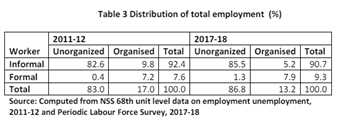Informalisation
-
- Informalisation of an economy is a situation wherein, the net output of informal economy as a proportion of total income remains high or increases over a period of time.
- An Informal economy consists of a diversified set of economic activities which do not have a formal employer-employee contract.
- This type of economy is minimally regulated by the government and there is a marked absence of social security benefits and formal working conditions.


-
- In terms of employment share the unorganised sector employs 83% of the work force and 17% in the organised sector.
- There are 92.4% informal workers (with no written contract, paid leave and other benefits) in the economy.
- There are also 9.8% informal workers in the organised sectors indicating the level of outsourcing.
Reasons for Informalisation
1. Low Levels of Skill in the Labor Force
Insufficient formal skills, with only 21.2% of the Indian labour force being skilled, contribute to the growth of informal employment.
2. Outdated Education System
A mismatch between educational offerings and market demands leads to poor skill acquisition, fuelling informalisation in the Indian economy.
Increasing Competition in the Formal Economy
Intense market competition drives companies to cut labour costs, fostering informalisation within formal businesses.
3. Globalisation and Unrestricted Imports
Imported goods from economies with lower labour costs, such as cheap clothing from Vietnam and Bangladesh, impact traditional industries and drive informalisation.
4. Rigid Labour Laws
Stringent regulations prompt companies to subcontract work, reducing compliance burdens but increasing informal economic activities.
5. Dominance of the Service Sector
A service-oriented economy with a weak manufacturing base results in a surplus of service providers, contributing to the growth of informal employment.
Gig Economy
A gig economy is a free market system in which temporary positions are common and organizations hire workers for short-term commitments rather than permanent workers.
Gig workers are independent contractors, online platform workers, contract firm workers, on-call workers, and temporary workers. They enter into formal agreements with companies to provide on demand services to the company’s customers.
India’s Booming Gig and Platform Economy
(A Report on Gig Economy in India)
-
- It was released by the NITI Aayog in 2022.
- The study estimates that in 2020-21, 77 lakh (7.7 million) workers were engaged in the gig economy.
- The gig workforce is expected to expand to 2.35 crore (23.5 million) workers by 2029-30.
- At present about 47% of the gig work is in medium skilled jobs, about 22% in high skilled, and about 31% in low skilled jobs.
- Trend shows the concentration of workers in medium skills is gradually declining and that of the low skilled and high skilled is increasing. It may be expected that while the domination of medium skills would continue till 2030, gig work with other skills will emerge.

